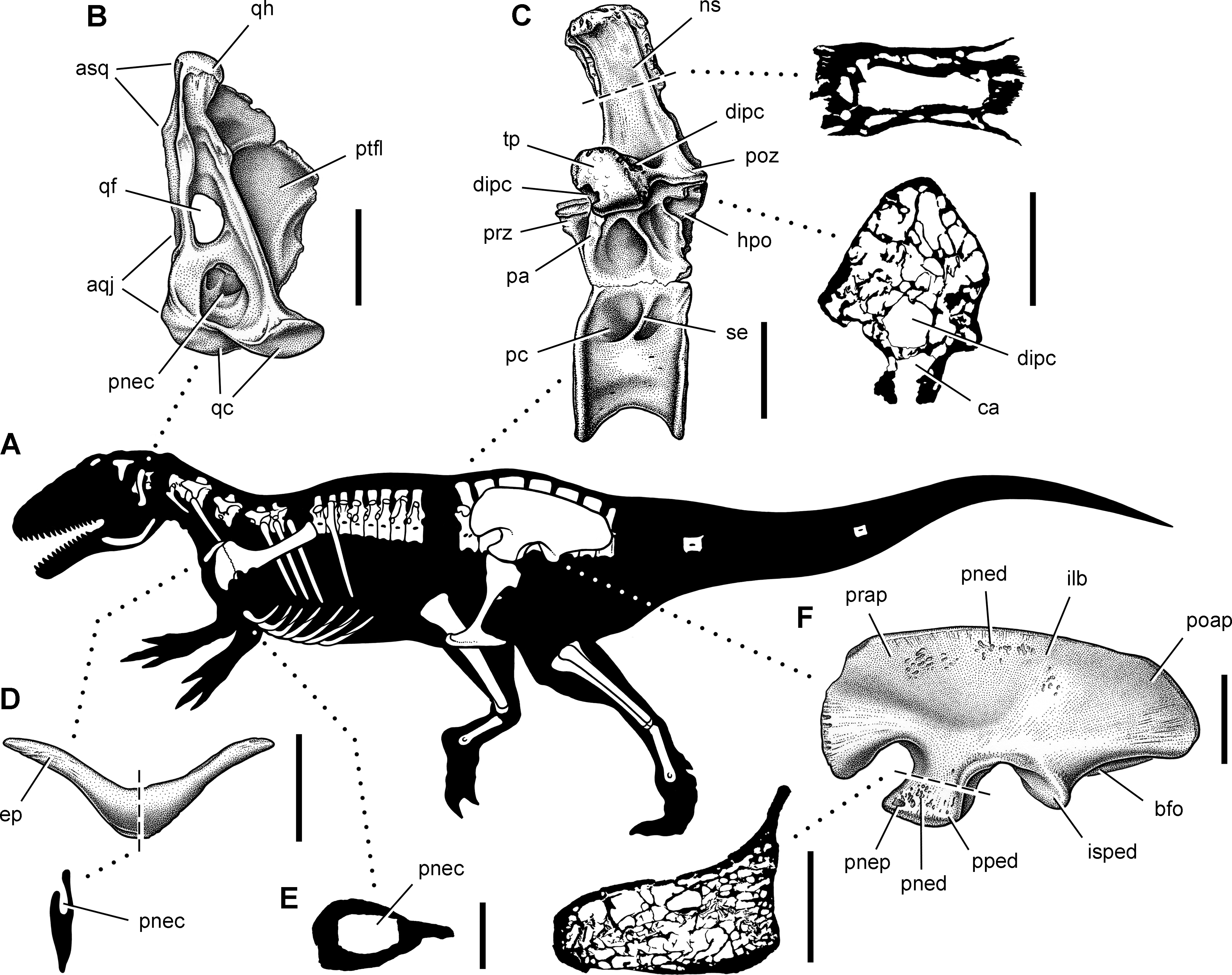- Aerosteon
Taxobox
name = "Aerosteon"
fossil_range= Fossil range|84Late Cretaceous

image_width = 250px
image_caption = Pneumatic features of "A. riocoloradensis"
regnum =Animal ia
phylum = Chordata
classis = Sauropsida
superordo =Dinosauria
ordo =Saurischia
subordo =Theropoda
unranked_familia =Tetanurae
superfamilia =Allosauroidea
genus = "Aerosteon"
genus_authority = Sereno "et al"., 2008
subdivision_ranks =Species
subdivision =
* "A. riocoloradensis" Sereno "et al.", 2008 (type)"Aerosteon" is a
genus of tetanurantheropod dinosaur from theLate Cretaceous period ofArgentina . Its remains were discovered in 1996 in the province ofMendoza . They show evidence of a bird-likerespiratory system .cite journal |author=Sereno PC, Martinez RN, Wilson JA, Varricchio DJ, Alcober OA, "et al."|year=2008|month=Sept|title=Evidence for Avian Intrathoracic Air Sacs in a New Predatory Dinosaur from Argentina.|journal=PLoS ONE|volume=3|issue=9|pages= e3303|doi=10.1371/journal.pone.0003303|url=http://www.plosone.org/article/info%3Adoi%2F10.1371%2Fjournal.pone.0003303|accessdate=2008-09-29] "Aerosteon"'s name can be translated as "air bone" and derives from Greek αέρως ("aeros", "air") and οστέων ("osteon", "bone").Description
"Aerosteon" was a 9
metre (30 ft) longbipedal carnivorous dinosaur that lived approximately 84 million years ago during theSantonian stage.The remains discovered include a single tooth, some cranial bones, a number of partial or complete
vertebra e from the neck, back, andsacrum , severalcervical anddorsal ribs,gastralia ,furcula (wishbone), leftscapulocoracoid , left ilium, and left and right pubes. The incomplete fusion of some of its bones indicate that it was not quite fully mature."Aerosteon" does not appear to belong to any of the three groups of large theropods that are known to have inhabited the southern continents during this time (cf.
Abelisauridae ,Carcharodontosauridae ,Spinosauridae ). It may represent a new group or be a late-surviving basal tetanuran. Sereno has suggested that it might be related to theAllosauroid radiation of theJurassic period.The
type species and only known species is "A. riocoloradensis". Its specific name indicates that its remains were found in theRio Colorado Formation .Physiology
Some of "Aerosteon's" bones show pneumatisation (air-filled spaces), including pneumatic hollowing of the furcula and ilium, and pneumatisation of several gastralia, suggesting that it may have had a respiratory air-sac system similar to that of modern
bird s. These air sacs would have acted like bellows, moving air into and out of the animal's relatively inflexible lungs, instead of the lungs being expanded and contracted as occurs withmammals . See avian respiratory system for more detailed information on this.Sereno theorises that this respiratory system may have developed to assist with regulating body temperature and was later co-opted for breathing.
References
External links
* [http://news.nationalgeographic.com/news/2008/09/080929-new-dinosaur-missions.html New Birdlike Dinosaur Found in Argentina]
* [http://www.scientificblogging.com/news_releases/aerosteon_riocoloradensis_meat_eating_dinosaur_had_bird_like_breathing Meat-eating dinosaur had bird-like breathing]
* [http://www.washingtonpost.com/wp-dyn/content/article/2008/09/29/AR2008092903475.html Dinosaur predator breathed like a modern bird]
Wikimedia Foundation. 2010.
